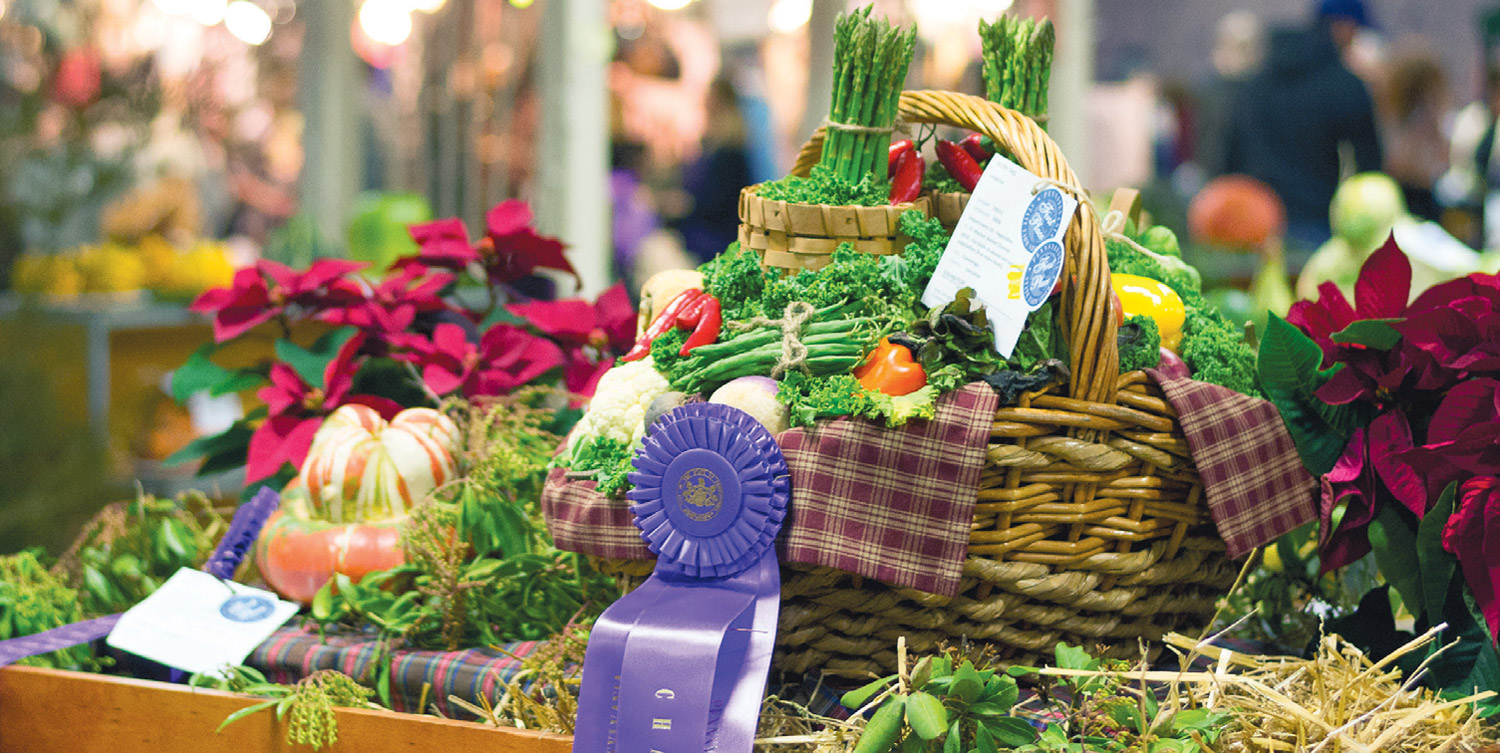Pennsylvania Farm Show
If you take the long way to Harrisburg via the Lincoln Highway (Route 30), snapshots of America unfold as if the decades are tracked in 20-mile segments. One of the country’s original transcontinental roads, constructed circa 1912, it runs from Times Square to San Francisco—but not without dipping through Philly first. This portion of the route was carved from 18th-century wagon trails on which produce was brought to market.
Back then, Pennsylvania was the budding nation’s agricultural powerhouse. You’ll learn at the Pennsylvania Farm Show that it still packs a punch.
As you drive, urban sprawl gives way to kitsch, which yields to rolling farmland. Dairy cows in chocolate tones graze on. Beneath their hooves, especially toward Pennsylvania Dutch Country, is some of the richest nonirrigated farming soil in the world. This makes the Lincoln Highway a revealing route to the show, which celebrates its 102nd birthday in January.
The country’s largest annual indoor agricultural expo, the Farm Show boasts a head-spinning array of attractions across 24 acres, drawing half a million visitors. No wonder: According to the Pennsylvania Department of Agriculture, the sector contributes $185 billion and nearly half a million jobs to the state economy annually.
Is the turnpike faster? Sure. But the Lincoln Highway provides a sense of place, which is ultimately what the show is all about. (To experience the countryside without the drive, take Amtrak’s Keystone Line.)
“The perfect Farm Show day
begins with hearing the
roosters crowing,” reflects
Bonnie McCann, communications
director. “Then going all of
the way through: Eat your
way through the farm show.”
Your mission: explore all things PA.-grown
If you’ve never been, picture the Farm Show as the quintessential country fair, crossed with an ag-focused trade show on overdrive. You might think of seminars on farm drones and the latest cow-milking tech, and that’s here. But so are blue-ribbon home bakers, rising chefs and the growers who make Pennsylvania such an amazing place to eat. It’s old-fashioned, cutting-edge and a rollicking good time.
During the 2017 opening ceremony, commodity princesses flanked Governor Tom Wolf and agriculture secretary Russell Redding as they welcomed the crowd. “The nature of agriculture is dramatically different than it was in 1917,” said Secretary Redding. He cast farming as a critical component of the future, noting that an increasingly engaged populace wants to know where their food comes from, how it was grown and who grew it.
Many of those answers can be found here.
“I grew up on a dairy farm and came to the Farm Show at a very young age,” says Laura England, director of the Bureau of Market Development for the Pennsylvania Department of Agriculture. “What was always neat was the opportunity for farmers to share stories. There is that true partnership between what happens on the farm and what ends up on someone’s dinner table.”
It’s a sentiment you’ll hear many times over, and you don’t need a green thumb to attend. With a nearly endless array of PA-grown culinary temptations on offer, including close to 6,000 animals and 10,000 exhibits, even the least agriculturally inclined visitor is left riveted—if in need of stretchy clothes. (If you remember only four words, make it these: Pennsylvania Dairymen’s Association milkshake!)
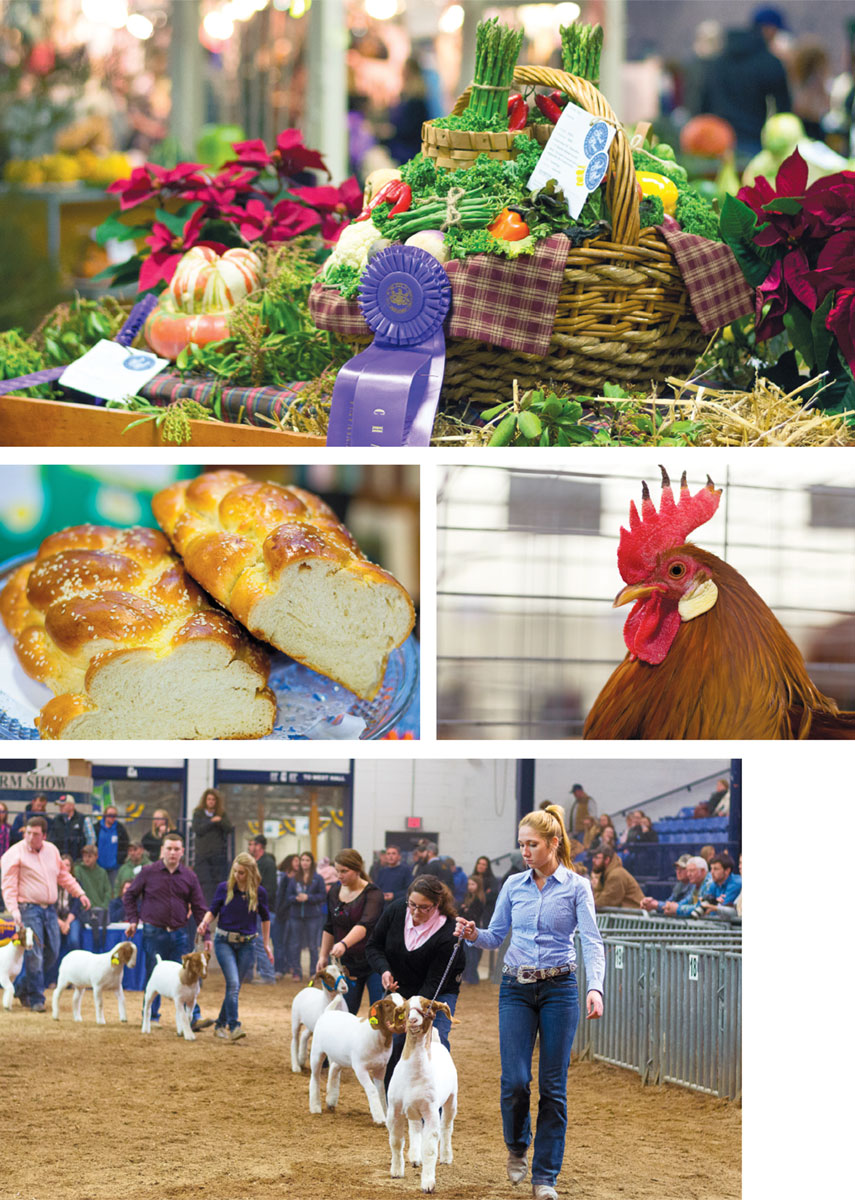
CLOCKWISE FROM TOP: Amy Livengood of Conestoga’s market basket hit a high note; a rooster shows off his comb; Grand Champion Junior Market Goat competition; swoonworthy challah in the Family Living exhibit
Blue-ribbon exhibits: generational pride
When many of today’s growers were kids, Farm Show visits were a rite of passage. For some, it was about gleaning industry knowledge. For most, it was about tapping into regional pride, and perhaps earning a few blue ribbons along the way. Much like at the state’s county fairs, competitors come from far and wide to compete in categories from Largest Potato to Grand Championship Christmas Tree.
“Agriculturalists are very proud of what they do, whether they are bringing their best pumpkin to the exhibit or their livestock,” says Heidi Svonovec. Raised on a sheep, cattle and hog farm, she is now assistant executive director of the Pennsylvania Farm Show Complex and Expo Center. Executive director Sharon Altland sees that as a powerful form of legacy. “Passing the 100-year marker, we have families that have been exhibiting for generations. Their great-great-grandfather came in, and then their grandfather, and mom and dad. It’s very deep-rooted.”
That description fits Bruce Hollabaugh, a third-generation grower from Adams County. In 1955, his grandfather Donald and great-uncle Harold launched the family farm, now 500 acres, where a core crop of apples and peaches is complemented by local veg. When he was a kid, farm show visits were part of their winter rhythm. Back then, farmers competed in county displays. At four or five years old, Hollabaugh would go to the local fire hall with his elders to witness the apple selection. “There would be all of these older fruit growers from all over the place. They would put all the apples out on the table and select, and then we would go to the Farm Show and display.”
His family continues to garner their share of honors—including the coveted Best Bushel—and Hollabaugh makes it a point to involve his children. In so doing, he echoes a sentiment passed down from his mother: as growers, part of the job is to teach the next generation the value and reward of hard work.
“My kids love to go see the displays and all of the beautiful apples,” Hollabaugh says. “But what I want them to see is that it starts all the way back in the winter of the year before, when we’re pruning our trees, and starting the process of growing the best apples we can grow. It’s an investment of yourself, really, because it’s part of what you do and who you are.”
Hollabaugh lights up when he talks about his industry. “When you think about Pennsylvania’s 12 million or so apple bushels alongside Washington state’s 150 million bushels, we’re talking about competing with very large, heavy-producing states,” he says. “Yet little Adams County, right down here in south-central Pennsylvania, is the fourth-largest in the country in terms of production by volume. That’s something we certainly hang our hat on.”
His advice: Don’t miss the apple dumplings at the food court. And bring the kids.
“Food is happiness,” says Carrie Lapore, deputy secretary of the Office of Marketing, Tourism, and Film within the Department of Community and Economic Development. “With consumers becoming savvier about wanting to know where their food comes from, if we can couple that with entertainment and include their children, that’s a big draw.”
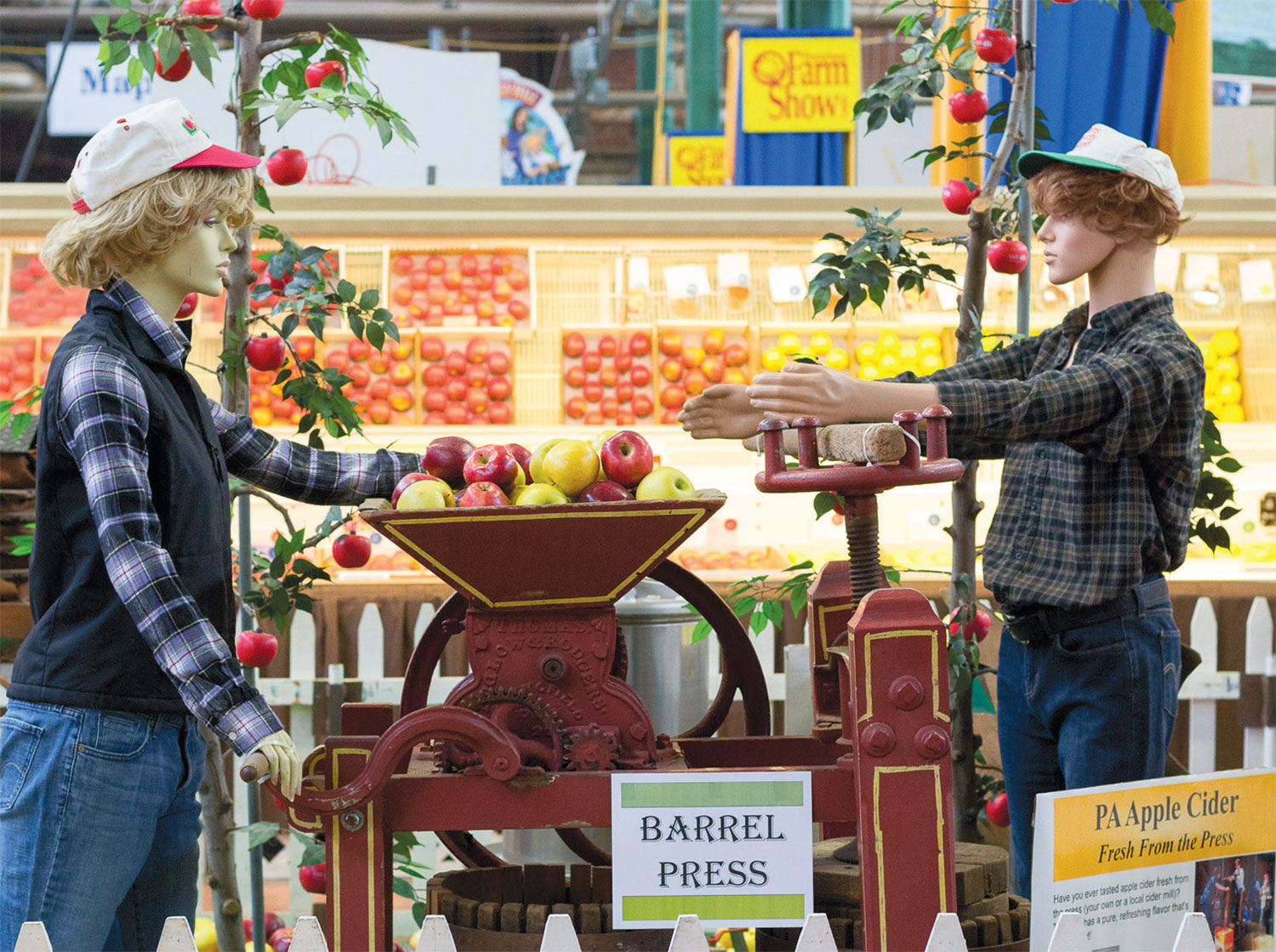
Displays reveal nuances of PA ag
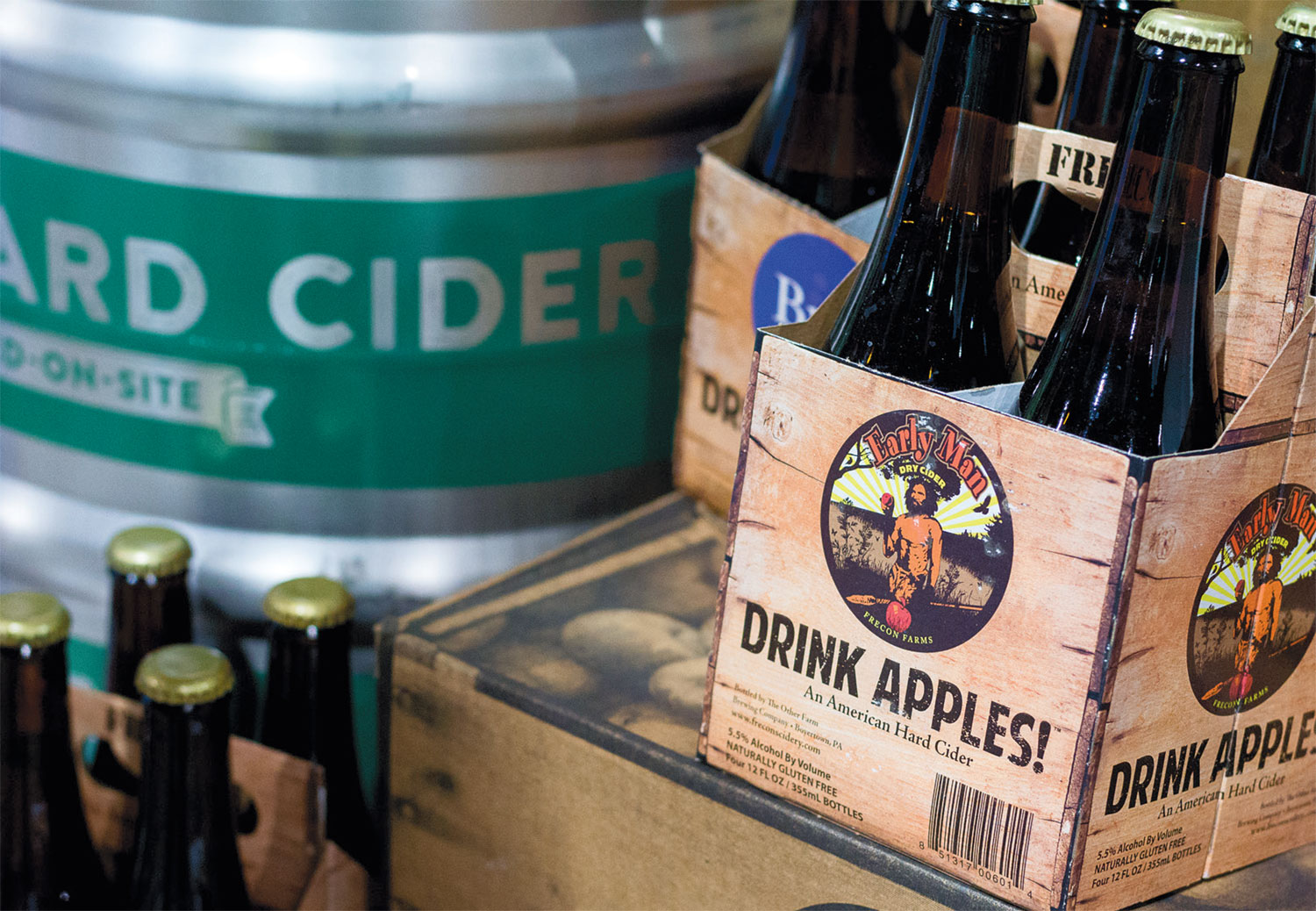
In an apple-producing state, cider abounds
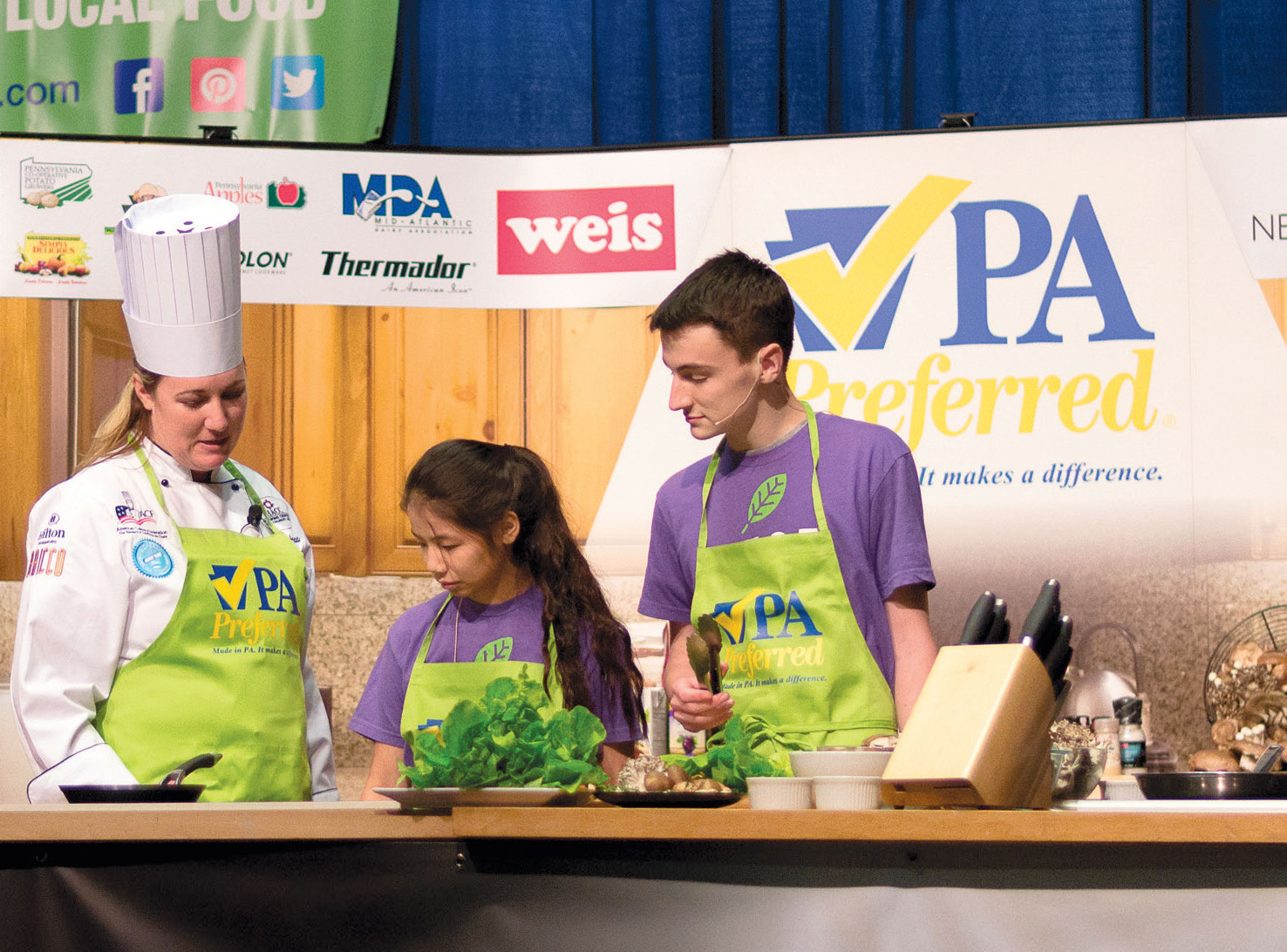
Students from the L.E.A.F. youth leadership program join Chef Autumn Patti on the Culinary Connections stage
Make culinary connections
For all of the lifelong Farm Show attendees, there are others who have never attended, even in nearby Lebanon County. This surprised chef Brian D. Peffley, a pastry instructor at the Lebanon County Career and Technology Center (CTC). So he decided to do something about it.
At first, that meant field trips, during which he and his culinary-arts counterpart, chef Robert Corle, exposed students to the mind-boggling array of PA products. They saw tractor displays and exhibits that tracked a crop’s path to the kitchen. They talked ingredients with farmers.
Yet it was the Family Living displays—where time-tested arts such as sticky-bun baking, preserving and quilting are feted—that captured students’ imaginations. Specifically: the gingerbread displays. “They said, we make gingerbread houses. Why can’t we compete?” Now, classroom projects are designed to Farm Show specs.
Peffley also enters his own ribbon-worthy confections, inspired by Lebanon County. In 2017, Victorian-era Tulpehocken Manor in Myerstown was rebuilt in sugar, bedecked with candlelit windows, wreaths and festive red bows. The year prior, his muse was more personal: a pink Victorian home in honor of breast-cancer awareness as a tribute to his late mother. Sweet architecture, however, is only one part of the experience.
Peffley and Corle’s students also have a strong presence at the show’s PA Preferred Culinary Connections stage. There, a roster of “rock-star” chefs demonstrate recipes made with PA Preferred produce. On Wednesdays and Thursdays, CTC students who keep their grades up get to work alongside them, doing all of the prep and even planning their own demos using recipes they develop in class.
Altland sees that as a win. “Culinary Connections is a great program. Getting people to understand the ingredients and how different foods can be prepared is huge. One of the things we’re charged with this year is still having the fun types of creative recipes, but getting back to basics. What can you do with a bag of potatoes? What are the different cuts of beef?”
Hungry visitors will do well to camp out at the stage and find out. Last year, the guest list included Christian DeLutis from Tröegs Brewing, Lance Smith from Harrisburg’s Millworks and former White House chef John Moeller. “It’s a huge stage to step out on to,” Peffley says. In networking with the chefs, many have found future jobs.
Bonus for onlookers: the stage is right next to the PA Preferred Marketplace, where hot-pickled eggs, Weaver’s Lebanon bologna and raw-milk cheese can be sampled.
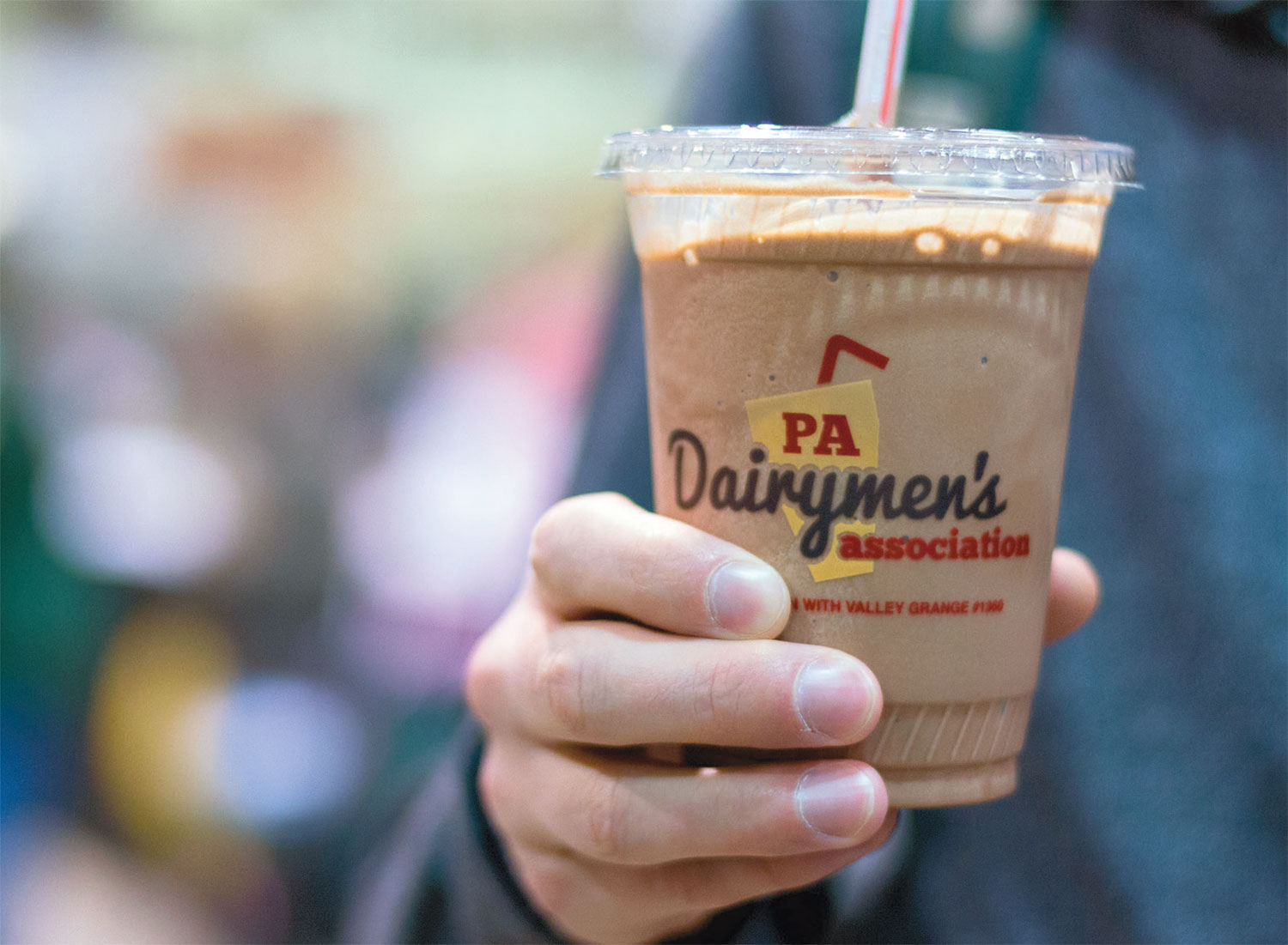
Everyone lines up for the PA Dairymen’s Association milkshake
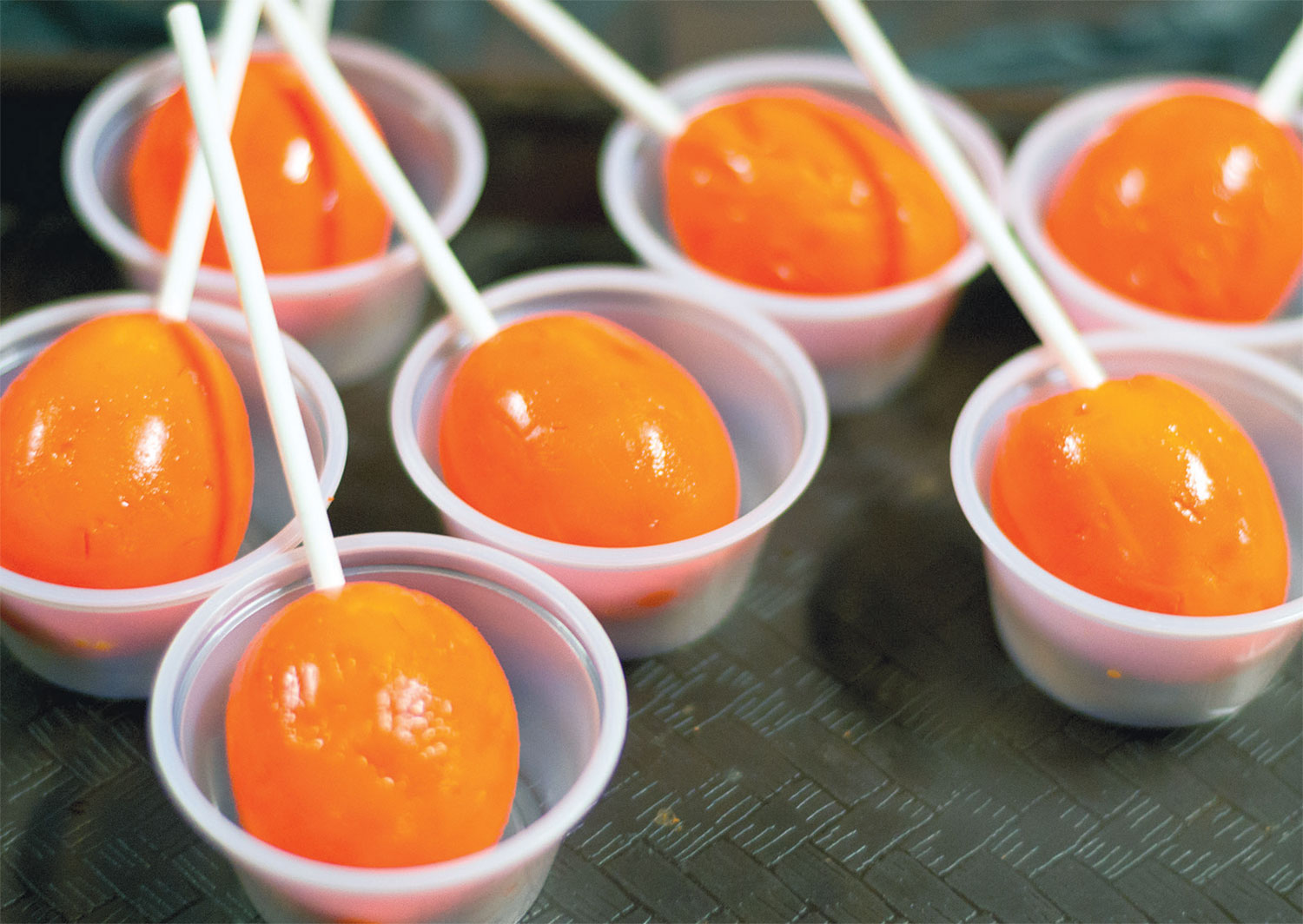
Hot pickled eggs are surprisingly craveable
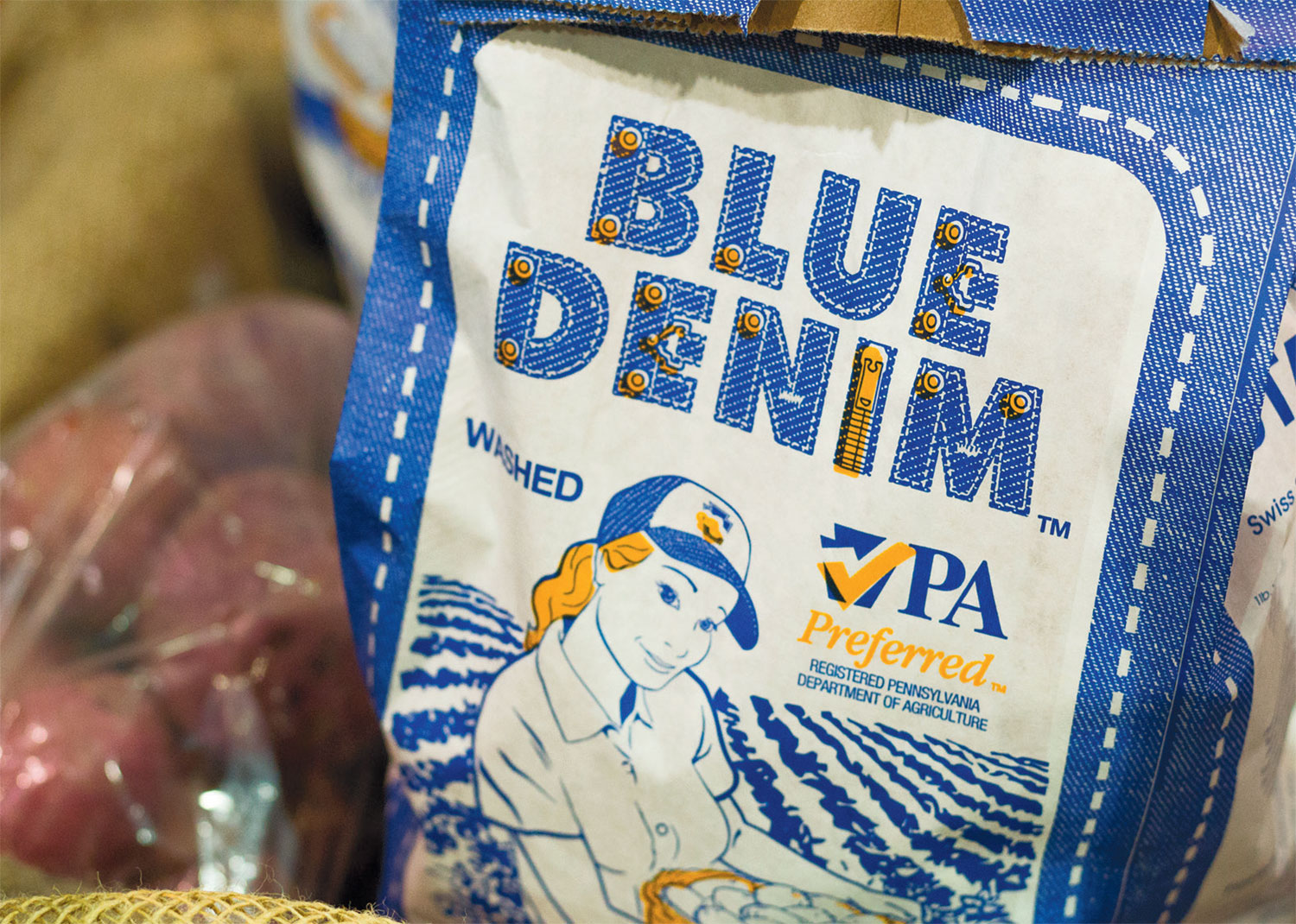
Pennsylvania has the oldest potato cooperative in the nation
Embrace a sustainable future
Like everyone, Peffley recommends quality time at the Food Court. As they say on the Farm Show website, “New Year’s Resolutions don’t count during Farm Show.” Good thing. In the carnivalesque wonderland, high-school-rodeo hopefuls and flannel-clad farmers rub elbows with sheepdog herders while downing gooey mozzarella cubes and potato donuts. Families line up for those much-loved milkshakes.
While indulgence is the game, there is a lot of history embedded in the offerings. The milkshakes were first introduced by the PA Dairymen’s Association in 1954, when they were individually handdipped. The Pennsylvania Cooperative Potato Growers are the oldest agricultural co-op in the country, circa 1922.
Carnival food aside, Peffley also commends the increase in sustainability-minded programming at the show, from the food to the exhibits. “People don’t want GMOs. People don’t want anything doctored: they want it real. It’s neat to see the evolution of that.” That sentiment reverberates for Karen C. Stark, cofounder of GMO-Free Pennsylvania. For the past several years, she has been a regular Farm Show volunteer with the Pennsylvania Association for Sustainable Agriculture, showcasing winter vegetables and chatting with attendees about sustainable food.
“There’s a locally produced and organic contingency in the state that wants to see that grow,” she says. “What our organic producers are saying is that we want more education—organic education. It’s good to see the Department of Agriculture stepping up.” Stark recommends visiting organizations like the Rodale Institute in the Know Your Farmer exhibit, which was created for the 100th anniversary.
This desire for more education resonates for the show’s younger attendees, who are eager to learn about sustainable growing practices. This includes Caroline Berry from Mechanicsburg Area High School, 16, who came to the show as part of the Landisburg-based LEAF Project. The program aims to cultivate youth leaders though internships in the food system, and at the Farm Show they did everything from prepping a VIP reception for Governor Wolf and conducting ag surveys to joining chef Autumn Patti on stage for a Culinary Connections demo.
“I interacted with a lot of people who represented big agriculture, and it was interesting to watch them interact with small, sustainable agriculture and their reactions to us, whether good or bad,” Berry says. “It was interesting to see a different perspective of agriculture.”
Dailah Mial, 16, from East Pennsboro High School, also got a new take on the show: “Previously it had been about getting milkshakes and seeing the animals. I feel like I got a better appreciation. I didn’t realize what they were trying to do. They were trying to get the community introduced to agriculture and the food system and I never realized that.”
LEAF cofounder and executive director Heidi Witmar hopes to see more programming that emphasizes diversity as the show enters its next century. “The kids feel this urgency of what’s going on in the food system and what they want to share,” she says. “They wanted to be having deeper conversations.”
Next year may be a good start: The theme for 2018 is “Strength in our Diversity.”
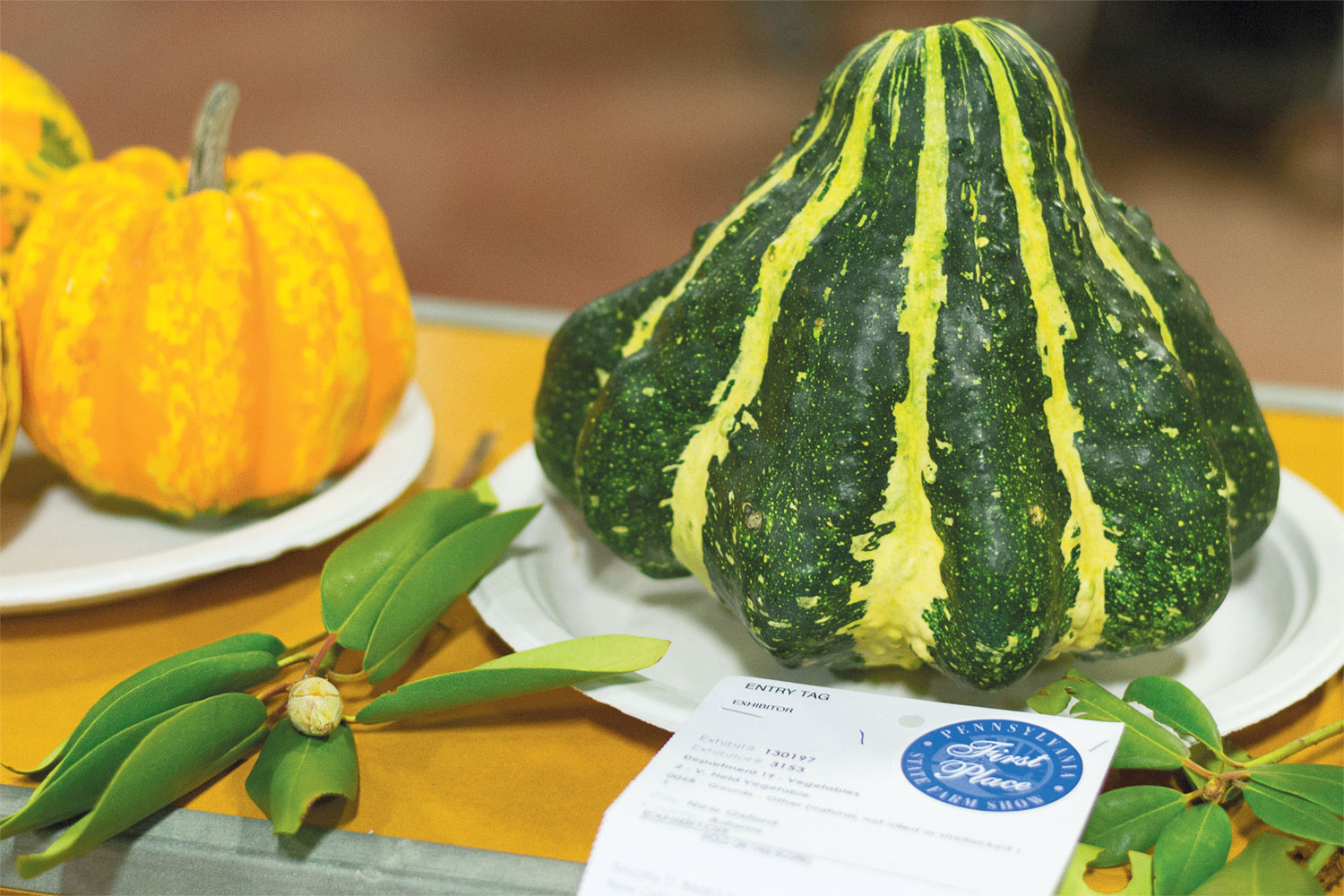
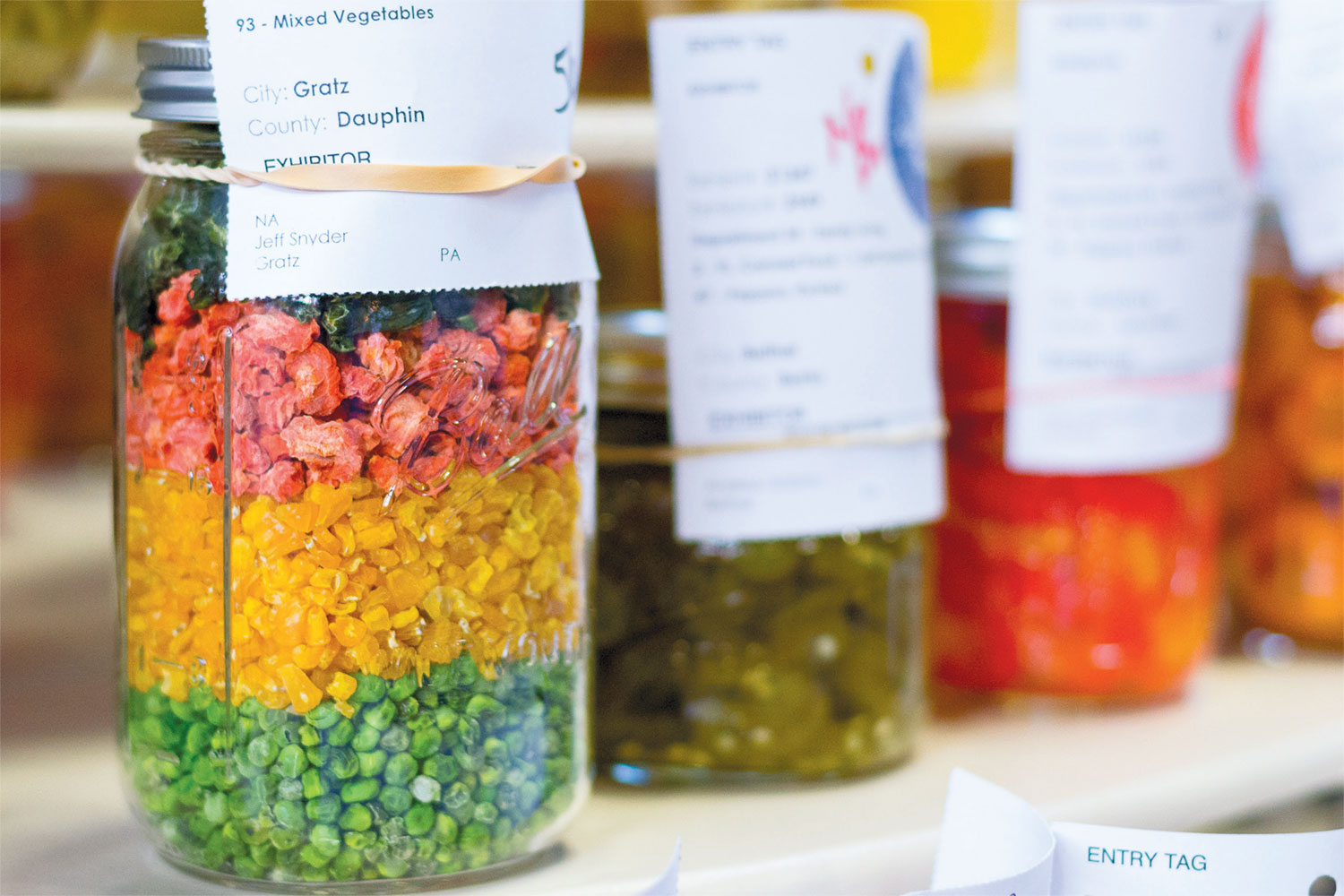
Fun for all
Rock-star PA chefs dishing demos by the hour? Check. Goats and poultry seeking best in show? Double check. Tastings of PA-grown foods? Checkmate.
The Farm Show may not technically have it all, but when it comes to farming, it gets mighty close. Big tractors meet baked potatoes. Sheep-herding trials and a no-joke competitive rodeo are accompanied by maple cotton candy and brisket. Add in tractor pulls and hallways packed with show rabbits, and you have the recipe for culinary adventure.
“The perfect Farm Show day begins with hearing the roosters crowing,” reflects Bonnie McCann, communications director for the show. “Then going all of the way through: Eat your way through the Farm Show, and then watch at least one cute kid curled up with their favorite heifer.” Whatever one chooses to do, one overarching theme ties everything together: From growers to eaters, we all have a place in Pennsylvania’s agricultural story.
102ND PENNSYLVANIA FARM SHOW
JANUARY 6 TO 13, 2018
2300 N. Cameron St., Harrisburg
farmshow.pa.gov
Admission, free. $15 to park.
Tip: Dress in layers and wear comfy shoes.

White House chef John Moeller on the Culinary Connections Stage
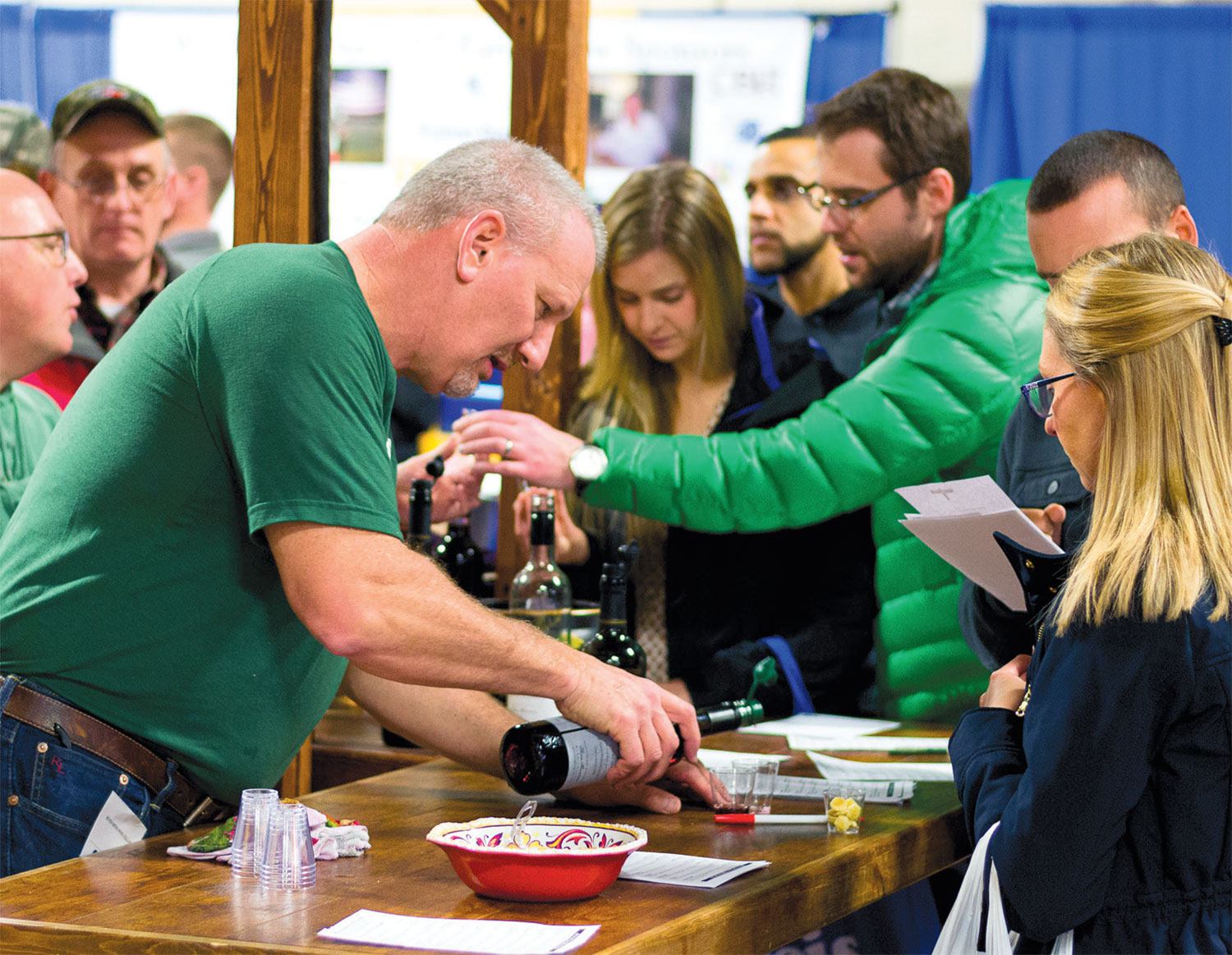
Seven Mountains Wine Cellars earned Best-in-Show honors for its 2015 Traminette
MUST-SEES
- Butter Sculpture: More than 1,000 pounds of butter is shaped into pastoral scenes.
- The Food Court: Eat PA food. Drink PA milkshakes. Repeat.
- Farm to Shelf: Track your food's path from field to pantry
- Ag 101: Quick-hit sessions cover topics like farm drones and trimming goat hooves .
- Calf Birthing Center (NEW): Get a true view of the dairy industry from its inception.
- Culinary Connections: Chefs cook. You sample. It’s the perfect combination. In 2018, expect more kids’ cooking sessions.
- Arena shows: From square-dance parades to goat shows, there’s something for all.
IN HARRISBURG
- Broad Street Market: Visit the oldest continually operated market house in the United States.
- The Millworks: Creativity takes all forms at this restaurant/brewery/gallery mashup.
- The Vegetable Hunter: Balance out your Farm Show indulgence with vegetable-forward fare and small-batch brews.
- The Midtown Scholar: This indie bookshop draws raves from readers.
- Tröegs Independent Brewing: In nearby Hershey, Chef Christian DeLutis brings brewery fare to another level—without getting fussy.


